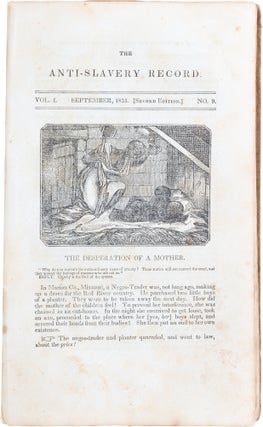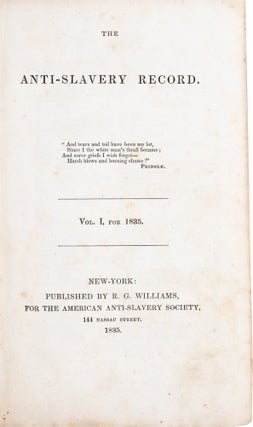The Anti–Slavery Record. Vol. I, numbers 1–12
New York: R. G. Williams, for the American Anti–Slavery Society, 1835. First Edition. Hardcover. 12 vols. in 1. 1st edition of the opening salvo in the brusque and unrestricted campaign against slavery in the U. S. 1st issue with installment number 12 (Dec.) stating “First Edition” in letterpress at the top of its first page. 1st binding with blindstamped decorations to the front cover and no blindstamped rules. The book is a collected run of the 12 monthly issues from the first year, bound by the publisher in cloth, and adding an index at the front and a critically important 30 page appendix at the back. Original cloth, gilt titled spine, light wear, some spots, cords a bit loose in a few places but holding firmly, the free endpaper, flyleaf, and page 73 each with a chip to the lower blank corner, 3 former owners names to the endpapers, but withal very good, unrepaired, honest as a sunburn, and complete with all 3 blanks and all the grizzly woodcuts. Coll: 8vo. pp. [i-iii] iv, [1] 2–174. Ref: Afro–Americana 622. Slavery in the United States I:161. very good. Item #415
Seems rare. OCLC located 6 copies in libraries, not all of them the 1st issue or in the publisher’s cloth, and just 1 copy (a 2nd issue) has sold at auction in the last 40 years.Credible data supporting the conclusion that 1st state, 1st binding copies are analogous to the Abominable Snowman whose footprints are everywhere, but who is nowhere to be seen. This book has some pensive heft and yet few collectors are seeking it, because buying 1st editions has similarities to picking raspberries. You have to look from more than one angle, or you are going to miss a lot. The American Anti–Slavery Society was the largest, and most influential, organization opposing slavery up to the Civil War, and William Lloyd Garrison was identified as “the chief apostle” of abolitionism by no less than Frederick Douglass himself. Garrison began by editing The Liberator (an anti–slavery newspaper) in 1831, when the topic was stickier than a campfire marshmallow. In 1832 he founded The Abolitionist Anti–Slavery Society of New England, reformed it into the Anti–Slavery Society in 1833, and began publishing this monthly in 1835. From the first issue he pressed free Americans to identify, and to understand that though slavery is the unequaled horror, in any life filled with violence, poverty, ignorance, monotony, pain, hopelessness, and bigotry, we are all brothers and sisters because such a life will crush your soul no matter what color you are. The first 7 issues sold well enough and the 8th issue (Aug.) sold out and was reprinted, as were the other issues thereafter. At year’s end, coinciding with publication of the Dec. number, Garrison added an index and the sagacious 30 page appendix, and offered this bound volume of the accumulated 12 issues. The first 7 issues were, at the outset, the unsold remainders from their 1st (only) printing. The next 4 issues were the unsold remainders from the 2nd printing. The final number (Dec.) drew from the 1st printing until copies were depleted and then from a 2nd printing, and it is this identifier of the Dec. number that is what differentiates the 1st issue of the book from the 2nd issue of it. Filling these 12 installments are reports on the slave trade and slave auctions, contributions by abolitionists such as Timothy Weld, Elizur Wright, and John Rankin, and eyewitness accounts of violence committed against slaves including narratives, and images of torture and murder, that would embarrass a shockproof watch. A book so central to African American history that it ought to have a horn section. The 11 unrestrained woodcuts (starting in no. 2) dramatize the evils of slavery, over such titles as “The Flogging of Females” and “The Desperation of a Mother” shown about to kill her two infant children, rather than lose them (see the illustration above). A caption underneath this woodcut is a question sent to the publisher, reading, “Why do you narrate the extraordinary cases of cruelty? These stories will not convert the cruel, and they wound the feelings of masters who are not so.” The publisher’s curt reply was, “Cruelty is the fruit of the system.” A 12th illustration, in the appendix (only issued with the bound volume), depicts both sides of the British Abolitionist Commemorative Medal.
Price:
$3,500.00





